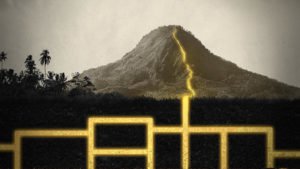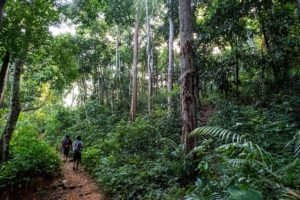Tonight’s the night for Episode 2 of the History Channel’s fascinating adventure: Lost Gold of World War II. This episode has an added interest for the drone industry, as a drone pilot and two data scientists from leading drone firm PrecisionHawk used LiDAR-equipped drones to help find a real life treasure.
“Lost Gold of World War II uncovers the quest to solve one of the last great mysteries of World War II,” says the show description. “In 1945, as Allied forces closed in, Japanese troops commanded by the notorious Japanese General Yamashita allegedly buried a fortune in treasure in the Philippines. It’s believed the treasure included gold, jewels, and priceless artifacts stolen from many nations.”
“Now, a team of Americans follows the lead of an eyewitness who says he saw Yamashita’s forces bury countless boxes in tunnels, sealed with explosives, and riddled with booby-traps. The team must decipher a bizarre code believed to be left by a s
ecret society, as a means to avoid the traps and recover the treasure.”
To help the team find their way through the dense rainforest, PrecisionHawk was approached by the producers. (Jaimie Young, PrecisionHawk’s General Manager of LiDAR, is a recognized expert in the LiDAR industry and has worked on other productions.) Through the combination of air and ground sensors, including a DJI M600 equipped with a Riegl miniVUX LiDAR sensor and a Sony a6000 camera, the PrecisionHawk team produced a colorized 3D map of the forest.
DRONELIFE interviewed the PrecisionHawk group: Jaimie Young, Jill Wren (LiDAR Scientist, and PrecisionHawk’s Director of Operations, LiDAR) and Matt Tompkins, Director of LiDAR Flight Operations. Join us for an insider look at how the 4-day mission was performed: dealing with everything from monsoon rains, an ex-special forces security team, and buffalo.
Jaimie, with more than 20 years of experience in all phases of LiDAR, was the one who was filmed; Jill did the processing and acted a flight observer; and Matt was the drone operator for the mission.
DRONELIFE (DL): How did this project differ from your usual work?
Matt: Working with the production crew, our job is more production oriented – this was more about being integrated with another team. The conditions for flight were different because it’s a jungle – and we had to be self sufficient. Everything we needed, we had to bring with us. The weather was pretty interesting too, since it was monsoon season!
DL: How dangerous was this job?
Matt: The construction crew was very supportive, but we definitely tried to keep a low profile – we were careful about not being places we didn’t belong. It also comes down to conditions: the rain made climbing up the mountain pretty tricky, and you had to wade through a waterfall to get there. There were also caribou (buffalo) to contend with.
Jill: There were security concerns pretty much every where we went, so we had a constant escort – who was retired from the British Special Forces. He had a whole team.
DL: What unique challenges did this work present?
Matt: By far the most challenging aspect was the terrain – it was mountainous and pretty dramatic. It was also monsoon season – so it went from nice to torrential rain in minutes. With no radar or weather resources, you didn’t have a lot of advance notice, so if you were in the middle of a flight you just had to bring it in.
We sourced digital elevation models that we used to follow the terrain and maintain a consistent altitude over the terrain. Jaimie ensured that they were at the correct altitude. The canopy was very thick, and there were tall trees – we used both a digital elevation model and a visual feed.
Jill: We had a very slow internet connection, so everyone else had to get offline so that I could process. We brought one new drone, and then discovered that we had to add worldwide GPS options to the US GPS options.
Jaimie: The quality of the system that we used is second to none – we were actually pleasantly surprised at what we were able to get, it did a lot better job than traditional LiDAR could have performed. We were able to come in at different angles – to get a higher probability of getting through the canopy.
DL: How did the producers use the 3D map?
Jill: They made a ground model and removed the vegetation – from there you will have to see how they use it!
DL: Do you see LiDAR on drones being used more in archeology?
Jaimie: Yes, the red tape to use a drone equipped with LiDAR is so much less than with an airplane – and the drone flies much closer to the ground, so it’s both more cost effective, and more accurate. There are also the safety considerations – without a person in the aircraft, you’ve taken out a lot of risk.
All of the team members say that despite the difficulties, filming the show was a great experience. The one thing that they won’t tell us is whether or not the team eventually finds the gold – for that, you’ll have to stay tuned to Lost Gold of World War II.
Miriam McNabb is the Editor-in-Chief of DRONELIFE and CEO of JobForDrones, a professional drone services marketplace, and a fascinated observer of the emerging drone industry and the regulatory environment for drones. Miriam has a degree from the University of Chicago and over 20 years of experience in high tech sales and marketing for new technologies.
Email Miriam
TWITTER:@spaldingbarker
Subscribe to DroneLife here.
https://dronelife.com/2019/03/26/dronelife-exclusive-flying-drones-in-the-phillipines-to-find-lost-gold-an-interview-with-precionhawks-intrepid-team/
 Unmanned Aerial Vehicle The latest drone news
Unmanned Aerial Vehicle The latest drone news





